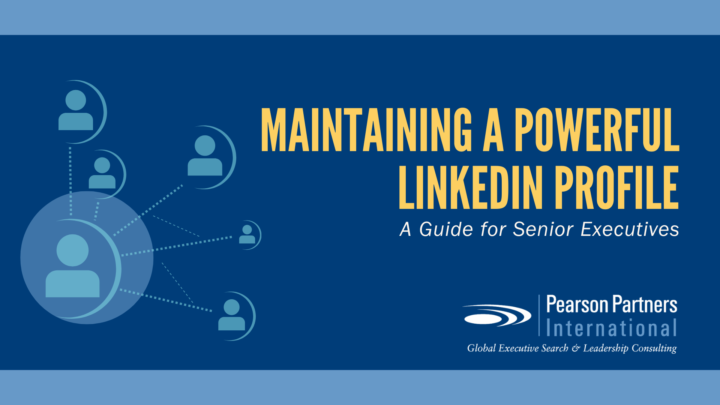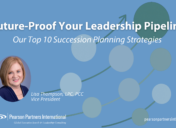Maintaining a Powerful LinkedIn Profile: A Guide for Senior Executives
Your LinkedIn profile is often your first introduction to potential employers, partners and colleagues. For senior executives, maintaining a powerful LinkedIn profile is a crucial tool for personal branding and networking, not just a summary of professional achievements like a resume. Keeping your profile updated and aligned with your professional goals is essential. Here are ten practical tips for senior executives on maintaining a powerful LinkedIn profile:
- Use a Professional Profile Photo and Cover Image. Your profile photo and cover image are your first visual impressions. Make sure they are:
-
- Professional: Use a high-quality headshot in professional attire rather than a casual photo.
- Updated: Replace your headshot regularly to reflect how you currently appear.
- Brand-consistent: Ensure the cover image aligns with your personal or corporate brand.
- Optimize Your Headline. Your LinkedIn headline goes beyond your current job title, encapsulating your expertise and the value you bring. It can also clarify your job title since titles vary in scope across industries. For senior executives:
-
- Focus on your core strengths and leadership qualities.
- Promote your professional brand. Since many people skim your profile, your headline is an opportunity to describe your expertise succinctly.
- Include keywords relevant to your industry and role, facilitating easier discovery by recruiters, potential employers and industry peers.
- Craft a Compelling Summary. The summary section offers a prime opportunity to tell your story. Aim for a narrative that:
-
- Highlights your leadership philosophy and accomplishments.
- Reflects your career trajectory, demonstrating growth and the impact you’ve made.
- Incorporates keywords to enhance visibility.
- Update Your Skills and Certifications. The skills and certifications section is not an afterthought but an important component of your LinkedIn profile. Ensure it reflects:
-
- The latest skills you have developed, especially those critical to executive leadership.
- Recent certifications or courses completed, showcasing your commitment to continuous learning.
- Customize Your LinkedIn URL. A customized LinkedIn URL looks cleaner on your business card or email signature and makes your profile easier to find. Aim for a URL that includes:
-
- Your full name.
- If possible, a professional qualifier (e.g., MBA, CPA, JD).
- Regularly Update Your Experience. Your professional experience should be more than a list of job titles. For each role:
-
- Detail your responsibilities and the strategic initiatives you have led.
- Quantify achievements with metrics to provide context and demonstrate impact.
- Update your experience section regularly to reflect new responsibilities and successes.
- Review and Refine Privacy Settings. Finally, review your privacy settings to ensure your profile’s visibility aligns with your networking and career goals.
-
- Verify your LinkedIn profile settings to specify who can see your connections, updates and various profile sections.
- Consider temporarily adjusting visibility settings while actively updating your LinkedIn profile to avoid repetitive notifications to your network.
- Check these privacy settings regularly, as LinkedIn frequently modifies features.
- Showcase Your Thought Leadership. Congratulations! Now that you have perfected your LinkedIn profile, it is essential to maintain your presence. LinkedIn is an excellent platform for sharing insight and adding value to your network, which will help position you as an expert in your field. Consider:
-
- Publishing articles on industry trends, challenges and innovations.
- Sharing relevant content with thoughtful commentary.
- Participating in discussions to elevate your status as an industry thought leader.
- Leverage Recommendations and Endorsements. Recommendations and endorsements from peers, colleagues and industry leaders lend credibility to your profile. To enhance this section:
-
- Politely ask for recommendations from those familiar with your work and leadership (and offer to recommend them in return).
- Endorse skills of your connections, encouraging reciprocity.
- Engage with Your Network. Active engagement on LinkedIn boosts your visibility and demonstrates your commitment to your professional community. Effective strategies include:
-
- Commenting on and sharing interesting posts.
- Congratulating connections on their professional milestones.
- Participating in relevant groups to expand your network.
For senior executives, maintaining a well-curated LinkedIn profile is crucial to personal branding and professional networking. By following these tips, you can ensure your profile accurately reflects your leadership caliber and expertise, positioning you favorably in your industry. Remember, a dynamic LinkedIn profile can be one of your greatest assets in your career and professional networking.
For more career insight for senior executives, see my companion article, Finding a Job After 50.
Related Posts
- ← The Shift from China to Mexico: Redefining Global Partnerships
- The Perils of Quiet Quitting: A Guide for Leaders →

















